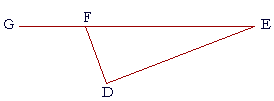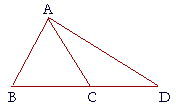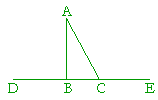Book I. Proposition 16Problems Back to Proposition 16. 1. In triangle DEF, side EF has been extended to G.
1. a) Name that exterior angle. To see the answer, pass your mouse over the colored area. Angle GFD. 1. b) Name the two angles that are interior and opposite to it. Angles FED, EDF. 1. c) Name the angle that is adjacent to it. Angle DFE. 2. a) State the hypothesis of Proposition 16. One of the sides of a triangle is extended. 2. b) State the conclusion. The exterior angle is greater than either of the opposite interior angles. 2. c) Practice Proposition 16. 3. Prove: From one point it is not possible to draw to the same straight line
That is, the straight lines AB, AC, AC cannot be equal in length, [Hint: Use the indirect method. Assume those lines are equal, and show how that leads to a contradiction.]
If AB is equal to AC, then in triangle ACB, 4. Prove: There is only one perpendicular to a straight line from a point not on it.
From the point A there is only one perpendicular AB to the straight line DE.
For suppose that AC is also a perpendicular to DE. 5. a) State the hypothesis of Proposition 17. This figure is a triangle. 5. b) State the conclusion. And two of its angles are together less than two right angles. 5. c) Practice Proposition 17. Table of Contents | Introduction | Home Please make a donation to keep TheMathPage online. Copyright © 2006-2007 Lawrence Spector Questions or comments? E-mail: themathpage@nyc.rr.com |


